This article relies largely or entirely on a single source .(June 2024) |

Gyrolithes is a trace fossil consisting of a vertically spiraling burrow, known from Cambrian strata onward. [1]
This article relies largely or entirely on a single source .(June 2024) |

Gyrolithes is a trace fossil consisting of a vertically spiraling burrow, known from Cambrian strata onward. [1]

The Cambrian is the first geological period of the Paleozoic Era, and the Phanerozoic Eon. The Cambrian lasted 53.4 million years from the end of the preceding Ediacaran period 538.8 Ma to the beginning of the Ordovician Period 485.4 Ma.
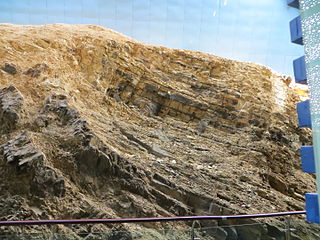
The Maotianshan Shales (帽天山页岩) are a series of Early Cambrian sedimentary deposits in the Chiungchussu Formation, famous for their Konservat Lagerstätten, deposits known for the exceptional preservation of fossilized organisms or traces. The Maotianshan Shales form one of some forty Cambrian fossil locations worldwide exhibiting exquisite preservation of rarely preserved, non-mineralized soft tissue, comparable to the fossils of the Burgess Shale of British Columbia, Canada. They take their name from Maotianshan Hill in Chengjiang County, Yunnan Province, China.
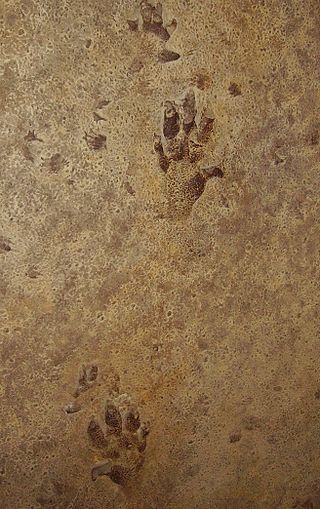
A trace fossil, also known as an ichnofossil, is a fossil record of biological activity by lifeforms but not the preserved remains of the organism itself. Trace fossils contrast with body fossils, which are the fossilized remains of parts of organisms' bodies, usually altered by later chemical activity or mineralization. The study of such trace fossils is ichnology and is the work of ichnologists.
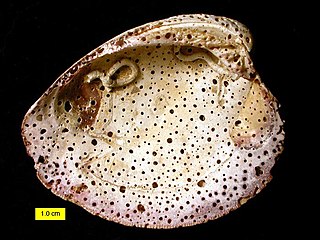
Bioerosion describes the breakdown of hard ocean substrates – and less often terrestrial substrates – by living organisms. Marine bioerosion can be caused by mollusks, polychaete worms, phoronids, sponges, crustaceans, echinoids, and fish; it can occur on coastlines, on coral reefs, and on ships; its mechanisms include biotic boring, drilling, rasping, and scraping. On dry land, bioerosion is typically performed by pioneer plants or plant-like organisms such as lichen, and mostly chemical or mechanical in nature.

Cephalonega stepanovi is a fossil organism from Ediacaran deposits of the Arkhangelsk Region, Russia. It was described by Mikhail A. Fedonkin in 1976

The Ediacaranbiota is a taxonomic period classification that consists of all life forms that were present on Earth during the Ediacaran Period. These were enigmatic tubular and frond-shaped, mostly sessile, organisms. Trace fossils of these organisms have been found worldwide, and represent the earliest known complex multicellular organisms. The term "Ediacara biota" has received criticism from some scientists due to its alleged inconsistency, arbitrary exclusion of certain fossils, and inability to be precisely defined.
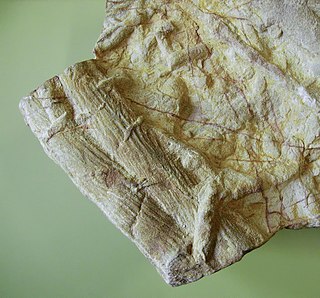
Cruziana is a trace fossil consisting of elongate, bilobed, approximately bilaterally symmetrical burrows, usually preserved along bedding planes, with a sculpture of repeated striations that are mostly oblique to the long dimension. It is found in marine and freshwater sediments. It first appears in upper Fortunian rocks of northern Iran and northern Norway. Cruziana has been extensively studied because it has uses in biostratigraphy, and because the traces can reveal many aspects of their makers' behavior.

The "Cambrian substrate revolution" or "Agronomic revolution", evidenced in trace fossils, is a sudden diversification of animal burrowing during the early Cambrian period.

Metaspriggina is a genus of chordate initially known from two specimens in the Middle Cambrian Burgess Shale and 44 specimens found in 2012 at the Marble Canyon bed in Kootenay National Park.
The Cambrian explosion is an interval of time approximately 538.8 million years ago in the Cambrian period of the early Paleozoic when a sudden radiation of complex life occurred, and practically all major animal phyla started appearing in the fossil record. It lasted for about 13 to 25 million years and resulted in the divergence of most modern metazoan phyla. The event was accompanied by major diversification in other groups of organisms as well.
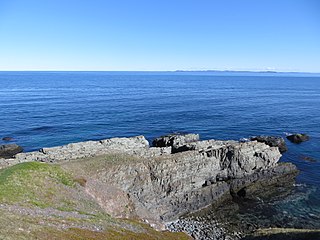
The Stratigraphy of the Cambrian period currently has several schemes used for ordering geologic formations from the period. The International Commission on Stratigraphy−ICS scheme has set a stratotype section for the base of the Cambrian, dated quite accurately to 538.8 ± 0.2 million years ago. Russian and Chinese scientists have developed a different scheme.
Monomorphichnus is an arthropod trace fossil known from the base of the Cambrian period onwards, before the first trilobite fossils.

Eldonia is an extinct soft-bodied cambroernid animal of unknown affinity, best known from the Fossil Ridge outcrops of the Burgess Shale, particularly in the 'Great Eldonia layer' in the Walcott Quarry. In addition to the 550 collected by Walcott, 224 specimens of Eldonia are known from the Greater Phyllopod bed, where they comprise 0.43% of the community. Species also occur in the Chengjiang biota, Siberia, and in Upper Ordovician strata of Morocco.
Stenothecoida is a taxon of bivalved fossils from the Early to middle Cambrian period. They look a bit like brachiopods or bivalve molluscs.

Allonnia is a genus of coeloscleritophoran known as complete scleritomes from the Middle Cambrian Burgess Shale. It is also a constituent of the small shelly fauna.

The Potsdam Sandstone, more formally known as the Potsdam Group, is a geologic unit of mid-to-late Cambrian age found in Northern New York and northern Vermont and Quebec and Ontario. A well-cemented sandstone of nearly pure quartz, in the 19th century it was widely used in construction and in refractory linings for iron furnaces.
Stage 2 of the Cambrian is the unnamed upper stage of the Terreneuvian Series. It lies atop the Fortunian and below Stage 3 of the Cambrian. It is commonly referred to as the Tommotian, after the Cambrian stratigraphy of Siberia. Neither the upper nor lower boundary has yet been defined by the International Commission on Stratigraphy. The preferred definitions for the lower boundary are the first appearance of the molluscs Watsonella crosbyi or Aldanella attleborensis around 529 million years ago. The correlation between the lowest occurrences of A. attleborensis and W. crosbyi with the Zhujiaqing positive carbon isotope excursion (ZHUCE) has led to the conclusion that the combination of these two markers are a reliable indicator of the boundary between the Fortunian and Stage 2. The proposed upper boundary might be the first appearance of trilobites around 521 million years ago.
The Hells Mouth Grits, formally defined and renamed the Hells Mouth Formation by Young et al., is a geological formation composed of Cambrian Greywackes in the south west part of St. Tudwal's Peninsula. Equivalent to the Rhinog Formation in the Harlech Dome, the grit beds exposed at St Tudwal's are very uniform in lithology and thickness when traced along the outcrops, with a gradual thinning southwards. They exhibit the characteristic textures and structures of greywackes but differ from the normal type in being relatively well sorted and commonly laminated. Intercalated mudstones are more variable both in thickness and in lithology and contain laminated mudstones rich in sponge remains. The sandstones have sharply defined bases, often bearing sole structures and occasionally loaded. Sandstone dykes cut down from the bases of some beds and extend through up to 0.6 m of underlying siltstones. The sandstones may form sheets up to 4 m thick, although a bed thickness of up to 1m is more usual, and have been interpreted as turbidites deposited by currents from the northeast.

A "Palaeopascichnid" describes a multitude of elongate fossils made up of multiple sausage-shaped chambers. They appear only in Ediacaran sediments. Fossils of Palaeopascichnids consist of an occasionally branching series of globular or elongate chambers. These fossils started appearing in the Vendian about 580 million years ago. Fossils of Palaeopascichnids are found in East European platform, Siberia, South China (Lantian), Australia, India (Tethys), Avalonia